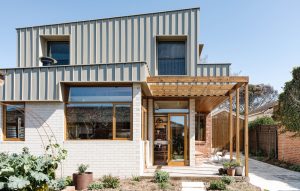A Guide To Curtains, Sheers + Blinds For Every Space
Interiors

In heritage or traditional spaces, consider pleated or gathered curtains on curtain rod. Photo – Tim Connelly

Pinch pleat, pencil pleat and S-wave – a few different curtain heading styles to consider. Photo – Courtesy of Luxaflex

These pencil pleat sheers hanging on a steel curtain rod work well in this classic interior space. Photo – Tim Connelly
Heritage + Traditional Spaces
In heritage and traditional spaces, curtains are king! They add so much drama and character to a space, and often also perform really useful functions including energy efficiency, great insulation and acoustic benefits.
A key distinguishing feature of curtains is the heading style – ie the way the curtains gather at the top. This feature alone can be either very traditional or more seamless and contemporary, depending on the style of the space and your preference.
A ‘pinch pleat’ style curtain is well suited to classic and heritage interiors. In this style of curtains, the bulk of the pleat is at the front of the heading, with two or three neatly pinched folds approximately 10cm down from the top of the curtain. This style of curtain can either be installed on a hidden track, or can hang on a curtain rods with rings.
A ‘pencil-pleat’ heading is a more relaxed, informal curtain style. This is achieved when heading tape is sewn onto a flat curtain and the strings are pulled until a natural gather appears in the curtain – it has a much less unstructured feel than a pinch pleat curtain, but still feels classic and well suited to a more traditionally styled interior space.
No matter which sort of curtains you choose, there is one golden rule to stick by – curtains should always skim the floor, never stop at the window ledge.

‘S-wave’ curtains work well in modern spaces, where windows tend to be larger and more seamless. Photo – Tim Connelly

S-wave curtains hang directly under a slimline track – this track can either be installed visibly, or disguised within a bulkhead. Photo – The Palm Co

In a new build or renovation, a designer will often design a bulkhead specifically to hide the curtain track, as seen here, where the S-wave is recessed into the ceiling. Photo – The Palm Co

Luxaflex’s ‘Pirouette Shadings’ beautifully complement this contemporary interior by Three Birds. Photo – The Palm Co

Luxaflex’s ‘Pirouette Shadings’ offer ultimate versatility in this elegant dining space by Three Birds. Photo – The Palm Co

Photo – The Palm Co
Modern + Architectural Spaces
In a modern home, windows tend to be larger and more frameless – this lends itself to slim, streamlined window furnishings that will give you maximum window coverage without looking ‘bulky’.
One of the most popular contemporary curtain styles are ‘S-wave’ curtains — a sleek, casual and contemporary style, with no pleating. The fabric folds in an ‘S’ formation underneath the track. This style tends to require more ‘stacking room’ than other styles, meaning when the curtains are open, they will require some room to ‘bunch together’ at the ends of the track.
Sheer curtains on an S-track look great on their own, particularly in living or dining spaces where privacy and full light block-out is not necessary. In spaces where more window coverage is needed, consider installing blinds behind a sheer S-track curtain. The blinds should be installed neatly within your window frame or alcove, whilst the sheer curtains cover the entire expanse of the windows, hanging from ceiling to floor.
Roller blinds are one of the the most common and cost effective blinds available, but if you’re after something more unique Luxaflex’s ‘Pirouette Shadings’ are an elegant option with softly curved, horizontal fabric vanes on a sheer fabric backing, these blinds allows natural light to softly filter through the sheer fabric when open, but can be flattened and closed completely when privacy is required.
One key consideration in contemporary spaces, is whether you will see the top of the curtain track, or conceal these elements. In a new build or renovation, a designer will often design a bulkhead specifically to hide these components.
Another question to consider is how high to install your curtain track. Generally speaking, in a contemporary home you can either install your curtain track directly above the window, or right up at the top of the ceiling. Both options work well in different contexts, but if you’re not blessed with high ceilings, it’s a good idea to install the curtains as high as possible on the wall, to give the illusion of more height.

Bedrooms often require a layered approach to window furnishings. In this space, sheer curtains are paired with blockout blinds, offering good flexibility for both daytime and evening use. Photo – Tim Connelly

Sleek S-wave curtains installed on the ceiling can help make ceilings feel higher. Photo – Tim Connelly

Luxaflex’s ‘Pirouette Shadings’ combine softly curved, horizontal fabric vanes on a sheer fabric backing, allowing natural light to filter through the sheer fabric when open. Photo – The Palm Co

Luxaflex’s ‘Pirouette Shadings’ are the perfect solution in the window seat of this dreamy bedroom by Three Birds. Photo – The Palm Co

Luxaflex’s ‘Pirouette Shadings’ allow natural light to filter through the sheer fabric when open, but completely flatten to provide full blockout coverage when closed. Photo – The Palm Co
Bedrooms
In the bedroom, you want your window furnishings to work really hard for you. You’re going to want privacy, as well as sunlight blockout for sleeping – and in some homes, thermal insulation can be a real asset too. For these reasons, in bedrooms a layered window treatment is often a good solution, here are 3 ideas to try :
Blockout blinds + sheer curtains in front — blockout for privacy and light control, and the sheer for ambience. This style works well in either traditional or contemporary spaces, depending on your aesthetic.
Blockout blinds + sheer blind on a double roller — in a modern space where gathered curtains aren’t the right look, consider a sleek double roller blind situation.
Sheer blinds + heavier blockout curtains — a good solution for older-style windows in heritage spaces, especially when you could use the extra thermal insulation provided by a heavier curtain.
In children’s rooms, any of the above can work, depending on the style of your home. The only real necessity for young children is blockout blinds, because we all know babies and young children need all the help they can get for an uninterrupted night’s sleep!
Bathrooms
In most bathrooms, the key requirement is privacy, and a seamless window treatment that won’t be damaged in a wet environment.
A simple roller blind is a great solution in the bathroom — semi sheer is sufficient for privacy, blockout is usually unnecessary in the bathroom. Alternatively, you might consider a slightly more design-led blind from Luxaflex’s ‘Soft Shades’ collection, like the ‘Pirouette Shadings’ pictured above .
With so many options available, selecting the right window coverings can sometimes be overwhelming. Get in contact with Luxaflex today, and let their expert consultants guide you through the process and provide the best solution for your home.



